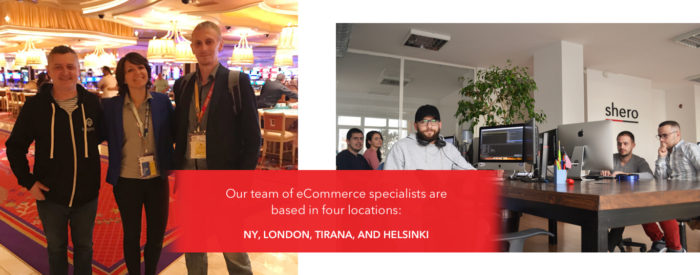Magento 2 continues to be a top choice in eCommerce platforms, and in this guide to Magento pricing, we’ll cover how much it costs to build and maintain a Magento store.
Plus, we’ll go over the details of each license — both pros and cons.
We originally published this article in 2013 as a definitive guide to Magento pricing, and as their offerings have evolved, we’ve continued to update this post over the years.
This includes the costs of buying a license, options for hosting, and other must-haves for running a successful Magento store.
This is a long read, so we’ve broken it down into parts:
Magento 2 Licensing Costs
Magento 2 Hosting Costs
Magento Open Source Pricing
Magento Commerce On-Premise Pricing
Magento Commerce Cloud Pricing
Magento 2 Development Pricing
How Much Does a Magento Website Cost Per Month?
Practical Tips & Reality Checks
The Big Question: How much does a Magento site cost?
Magento’s impressive customization capability remains its most powerful asset. So, when our clients ask us how much they can expect to spend on their website, we respond by asking them what exactly they want to accomplish.
Of course, the more details they can give us, the better answer we can give them. For example, this robust platform can support a digital Walmart, or a digital mom-and-pop. Finding out where a client fits on this spectrum will go a long way toward determining their expected costs.
But here’s the thing: There are so many different variables to building a custom Magento site, that it’s impossible to say, “This is exactly how much your site will cost,” without first discussing your business and your goals.
That’s because licensing costs do change for each business, based on unique factors like monthly revenue.
And sure, Magento Open Source is technically considered free, but if you need a developer to customize your site, costs will add up.
For instance, here’s how the Magento pricing model works.
- Magento Open Source is free as-is, but you’ll likely encounter additional development costs: hosting, design, SEO, maintenance and site updates, and more.
- Magento Commerce offers tiered pricing, based on your company’s Gross Merchandise Value (GMV). Extra costs, like hosting, are covered further down this article.
- Magento Commerce Cloud is also tiered, based on your GMV. But as an enterprise offering, hosting and other valuable services are included. More on that, later.
We’ll get straight to the point: The best way to get an accurate price is to contact us for a quote.
But, in this article we’ll cover what each plan will give you, any additional costs to anticipate, and why Magento is a worthwhile investment.
What This Guide to Magento Pricing Covers
If you were budgeting for a brick-and-mortar store, your total cost would depend on a lot of factors.
For instance, you might consider: How many stores you need, the size of the buildings, what equipment you’d need to use, what systems you’d need to run your operations, what builders you’d hire and their level of expertise, and more.
Running an online store isn’t all that different, in a sense.
To get an accurate idea for your Magento store costs, you need to weigh a few key factors:
- What Magento 2 product is best for my business?
- What is the best hosting site for Magento 2?
- How much customization does my site need?
- What third party costs are involved with a Magento eCommerce site?
This guide will walk you through those factors. We’ll cover:
- Base Magento 2 Licensing costs
- Hosting Options and Costs
- Magento 2 platforms and what each offers, broken down by:
- How Much Does a Magento Website Cost Per Month?
Magento 2 Product Overview
| Magento Open Source | Magento CommerceOn Prem | Magento Commerce Cloud | |
|---|---|---|---|
| Core Functionalities | |||
| Advanced Native Functionalities | |||
| Technical Support | |||
| Hosting & Performance |
With this information, you’ll be ready to assess your needs. We’ll bring it all together with typical cost ranges for three common site types.
Last, we’ll give you some of our best Tips and Reality Checks.
But first, let’s cover another big question that may be on your mind.
Who Should Read This Magento Pricing Guide
This guide is written for business owners, eCommerce directors, online merchants, and anyone exploring an investment in Magento. Whether you’re building a new site, replatforming from a SaaS site, or making the necessary upgrade from Magento 1, this guide is for you.
If you’re reading this, you likely already know that Magento is a powerful and popular eCommerce platform. And, you might have a good idea about the benefits of Magento.
Or maybe you’re just learning the basics—either way, you’re probably weighing whether Magento is right for your business.
To make that decision though, you need a clear idea of what you’d pay, why, and what your return on investment would bring—that means, no sales push, no high-level tech language, just the facts. If that’s you, read on.
But first, let’s cover another big question that may be on your mind: Who are we, and why should you listen to us?
Who Are We and Why Should You Trust Us?
A Magento Partner eCommerce Agency Based in NY with Offices Around the World
Shero Commerce is a global eCommerce development and marketing agency. We’ve built and launched more than 300 Magento sites for clients of all sizes since 2011.
From niche boutique to enterprise; B2C and B2B; major shipping ports to high-end lingerie; omnichannel, eComm-only, and everything in between—we’ve done it all.

Plus, Shero is a Magento Professional Solutions Partner, which means we get info straight from the source. Our team of eCommerce experts includes Certified Magento Developers and Solution Specialists.
Many of our team members have even been recognized as Magento Master Makers—an award given by Magento to recognize high-value contributors to the Magento community.
We have the extensive experience and expertise needed to guide you through Magento pricing.
Now, let’s get into the nitty-gritty.
Magento 2 Licensing Costs
Once you choose your license, the cost is easy to predict, whether you use Magento right out of the box or you customize your site to heck and back.
Licensing is the most logical starting point, because it’s the most predictable expense.
Remember, your total site cost is greatly affected by how much customization you’ll need. But your licensing cost isn’t affected by your customization.
Here’s the current licensing, set by Magento.
- Magento Open Source: Free
- Magento Commerce On-Premise: Tiered based on Gross Merchandise Value (GMV). Starts at $XX per year; increases for GMV over $1 million. Hosting not included.
- Magento Commerce Cloud: Tiered based on Gross Merchandise Value (GMV). Starts at $XX per year; increases for GMV over $1 million. Hosting included.
Magento Commerce Licensing
| Gross Merchandise Value (GMV) | Magento Commerce On Premise | Magento Commerce Cloud |
|---|---|---|
| $0 – $1M | $22,000 | $40,000 |
| $1M – $5M | $32,000 | $55,000 |
| $5M – $10M | $49,000 | $80,000 |
| $10M – $25M | $75,000 | $120,000 |
| $25M+ | $125,000 | $190,000 |
We’ve included price ranges here because the price you’ll pay for a Magento license depends on many factors and is difficult to pinpoint without knowing more information about your specific needs. Contact us for a personalized price quote for your business.
Here’s a high-level overview of what you get with each.
| Magento Open Source | Magento Commerce On-Premise | Magento Commerce Cloud | |
|---|---|---|---|
| Magento Product Feature Comparison | Open Source software for tech-savvy merchants | Enterprise-class native features & support | Enterprise-class features, hosting, & support |
| Promotions & Pricing | |||
| Search Engine Optimization | |||
| Site Management | |||
| Catalog Browsing | |||
| Product Browsing | |||
| Catalog Management | |||
| Integrated Checkout, Payment, & Shipping | |||
| Order Management & Customer Service | |||
| Support for Global Sites | |||
| Customer Accounts | |||
| Mobile Optimized Shopping | |||
| Architecture & Security | |||
| Multiple Store Views | |||
| Basic Analytics & Reporting | |||
| Layout & Theming | |||
| Product Configurations | |||
| Multiple Languages | |||
| Flexible Couponing & Promotions | |||
| Full Page Caching System | |||
| Instant Purchase | |||
| Basic Site Search | |||
| Extended Functionality via App Marketplace | |||
| Magento Community Forums | |||
| Rules-based Related Products | |||
| Rules-based Upsells & Cross-sells | |||
| Private Sales with Viral “Invite-a-Friend” Emails | |||
| Database Scalability | |||
| Advanced Site Search | |||
| Advanced Content Management | |||
| Message Queue | |||
| Reward Points | |||
| Extended Admin Permissions & Logs | |||
| Visual Merchandising | |||
| Gift Cards | |||
| Customer Segmentation | |||
| Customer Attributes | |||
| Content Staging & Preview | |||
| Banners | |||
| Database Sharding | |||
| Integrated B2B | |||
| Advanced Analytics & Reporting with Business Intelligence Dashboards | |||
| Magento Account Manager | |||
| Magento Technical Support | |||
| Access to Quick Design-Build Express Packages | |||
| Adobe Sensei AI-Powered Product Recommendations | |||
| Hosting & Performance | |||
| Optimized Cloud Commerce for Magento | |||
| Global Availability | |||
| Cloud availability SLA up to 99.99% | |||
| Fast Page Loading with Content Delivery Network (CDN) | |||
| Performance Monitoring Tools | |||
| Enhanced Security with Fastly WAF & DDoS Services. | |||
| PCI Compliant | |||
| Easy Deployment | |||
| Streamlined Updates & Testing |
Next, we’ll cover another basic cost: hosting.
Magento 2 Hosting Costs
Chose between Magento 2 managed hosting companies, Magento 2 Cloud hosting, Magento 2 in-house hosting, or Magento 2 on Amazon Web Services (AWS)
Many merchants overlook hosting costs in their budgeting. Yet, your hosting solution is critical to determining your site’s long-term success.
Remember that old real estate motto, “Location, location, location”?
Well, choosing your hosting provider is the digital version of choosing the right brick and mortar location.
- Magento Open Source: Needs a Host
- Magento Commerce On-Prem: Needs a Host
- Magento Commerce Cloud: Hosting Included
Unlike physical real estate, though, your hosting also affects many critical factors like security, speed, and performance.
Imagine if picking the wrong plot of land meant your doors could automatically lock customers out, shut down power during your busiest periods, or unlock your doors and open every register to thieves. Yikes! You definitely wouldn’t treat that decision as an afterthought.
That’s what your hosting can do—or prevent—for your site. Trust us, it’s worth careful consideration.
Because Magento is such a powerful platform, it’s a bit of a resource hog. You need a powerful and secure Magento-specialized host to keep your site at peak performance. (That’s true for all Magento 2 products.)
Optimized hosting is included with Magento Commerce Cloud. However, for Magento Open Source and Commerce On-Premise, you have three options:
- Hosting your site in-house
- Using a managed hosting provider who specializes in Magento hosting
- Hosting on AWS or Google Cloud.
At Shero, we work with multiple clients who are hosted on AWS. Make sure the agency you work with has experience with AWS and can help you support the site long-term.
Unless you already have sophisticated hosting ops or your industry makes it necessary (like CBD/cannabis or medical brands), we strongly discourage in-house hosting. The risks and costs are just too great.
For third-party hosting, our clients typically pay anywhere from $150 per month for shared hosting, up to $4,500 a month for multiple dedicated servers or cluster hosting environments.
Here’s how to determine what you’ll need in terms of Magento hosting infrastructure:
- Do you need shared hosting, dedicated hosting, or a multi-server/cluster environment?
- What edition (Open Source or Commerce) and version (2.x) of Magento will the website be built with?
- Is this a single store or multi-store installation? If multi-store, how many domains will there be?
- How many users per day does my website see on average and during peak traffic times?
- How many total product SKUs are in the database (including configurable items)?
- If the website is already being hosted, how much disk space are you currently using?
- Geographically, where are a majority of the website visitors coming from (North America/Europe/Australia, etc.)?
- What is the projected growth rates over the next 6 to 12 months (i.e traffic, orders, product skus)?
- What PHP version (5.X, 7.X) is the website currently built for or will need?
- Will you need Varnish, New Relic, or a third party search such as Elastic Search, SOLR, or Sphinx?
- Will you need a Content Delivery Network (CDN)?
- Do you require full site HTTPS?
- Will you require a development and QA environment to test changes to the website before you push to production?
- Will I use another service to monitor site performance, like Pingdom or New Relic?
For Magento Open Source, shared hosting may be sufficient, depending on your site size, demographics, and traffic. For Commerce On-Prem, you’ll need a dedicated environment at the very least.
We’ve worked with many hosting providers, and one of our favorites is Nexcess. They offer Cloud and Dedicated servers for Magento 2 hosting. Their hosting is reliable, compliant, and secure. Their staff is friendly, US-based, knowledgeable, and personable. And above all, their customer support is super fast.
Next, let’s get into the details of each Magento 2 product, so you can assess which option is right for you.
Magento Open Source Pricing
Licensing: Free
Formerly known as Magento Community Edition (CE), Magento Open Source is the most popular Magento 2 product.
The Pros: With Magento Open Source, you get all the crucial basics, plus the customization options Magento is famous for. And, its core functionalities give you the solid skeleton you need to support any eCommerce operation.
Magento Open Source includes eCommerce must-haves like basic analytics and reporting, catalog management, mobile-optimized shopping, and flexible coupons and promotions.
With extensions and third-party services, you can expand almost endlessly, adding things like marketing tools, gift cards, or advanced site search.
Because it’s Open Source, there’s a thriving Magento Community to learn from.
And you can’t beat that licensing fee.
The Cons: Magento Open Source gives you access to a galaxy of possibilities, but includes none of the technical know-how to turn possibility into reality.
You’ll need a Magento-savvy developer or development team to set up, configure, and maintain your store. Managing inventory and content has a considerable learning curve, so your eComm team will need time and training to use it.
Remember those extensions and third-party services we mentioned? Business owner, beware. They’re often subscription-based, so the ongoing costs can add up quickly. You’ll also need a hosting solution.
Technical support is limited to your search skills and developer resources like Magento forums, Github, and StackExchange.
Standard, unavoidable maintenance like security patches will also require a developer. Customizations like extensions can complicate maintenance and increase your development costs.
Magento Open Source At A Glance
Core Functionalities: Included
Advanced Functionalities: Additional Cost
Hosting and Performance: Additional Cost
Ideal for: Small businesses in B2C, and merchants with a reliable and tech staff or agency skilled in Magento
Questions? Let’s see if Magento Open Source is the best fit for your online store.
Need a more robust option? Magento Commerce could be better for you.
Magento Commerce, formerly known as Magento Enterprise, has two versions: Commerce On-Premise and Commerce Cloud. The main difference is hosting.
Let’s break each option down.
Magento Commerce On-Premise Pricing
Once you choose your license, the cost is easy to predict, whether you use Magento as-is, or you customize your site with all the bells and whistles.
Licensing: Tiered pricing based on sales volume starts at $22,000 per year.
Formerly known as Magento Enterprise Edition (EE), Magento Commerce On-Premise (On-Prem) is an enterprise-level option without managed hosting or performance.
Pros: Magento Commerce On-Prem is tailored toward retailers with more complex eCommerce operations. It’s a muscular platform built on the bones of Magento Open Source, fully supported by Magento Account Management and Technical Support.
Commerce On-Prem’s expanded native functionalities give you more control, without the need for extensions or extra subscription services.
- Make data-driven decisions with advanced Business Intelligence Dashboards.
- Build brand loyalty with customer features like rewards and loyalty programs, gift cards, and private sales.
- Hone your marketing with advanced strategies like customer attributes, segmentation, upsells and cross-sells, and related products.
- Support your team and cut overhead costs with Magento’s page builder, integrated CMS, visual tools, content staging and automation, and extended admin permissions.
- Get help when you need it with access to real-human tech support.
The major difference between Commerce On-Prem and Commerce Cloud is hosting.
Because hosting isn’t included with On-Prem, you have more options. Your team can choose what’s best for your specific site, fine-tune your performance and security, and keep full control over response times.
Cons: Magento Commerce On-Prem has more out-of-the-box features than Open Source, hence the need for visual tools and bundled tech support.
The additional native functionalities and tech support will likely decrease your customization costs, but they won’t eliminate them. You’ll need developers to set up your site, configure it, and optimize it for your operations.
Like Open Source, you’ll need a Magento-savvy developer for maintenance like security patches. You’ll need to have a solid plan and team to address critical incidents, either in house or through an agency.
And of course, you’ll still need to pay for in-house or third-party hosting.
Magento Commerce On-Premise At A Glance
Core Functionalities: Included
Advanced Functionalities: Included
Hosting and Performance: Additional Cost
Ideal For:
- B2B and B2C merchants who make most of their revenue through eCommerce
- More complex and advanced eComm operations and teams
- Merchants who need more control over hosting, performance, and security
Contact us to get a personalized quote and find out how much Magento On-Prem would cost for your online store.
What if you don’t need more control and don’t want the hassle of hosting? Magento Commerce Cloud may be perfect for you.
Here’s what you need to know about Magento Commerce Cloud.
Magento Commerce Cloud Pricing
This Magento license includes hosting and other valuable assets.
Licensing: Tiered pricing based on sales volume; starts at $32,000 per year
Formerly known as Magento Enterprise Cloud Edition (ECE), Magento Commerce Cloud is an enterprise-level option with managed hosting and performance.
Pros: Magento Commerce Cloud is the ultimate bundle of Magento services and features. Commerce Cloud has Open Source bones, On-Prem muscle, and skin to keep it all protected and self-contained.
It includes everything you’d get with Magento Open Source and Commerce On-Prem, plus bundled hosting, security, and performance. You get Magento support for everything.
From a development perspective, setup is relatively easy.
Commerce Cloud uses Git for version control, and the Magento Cloud CPI tool makes deployment simple.
It’s built on an AWS cloud server, which is quickly becoming industry standard. Integrated CDN and performance monitoring tools like New Relic and Blackfire.io cut down on additional expenses.
Commerce Cloud also shifts responsibility for critical incident response to Magento support.
That means you’re not paying for on-call techs or scrambling to beef up security in the event of an attack.
Cons: The biggest drawback is the cost. Because it bundles advanced functionalities, support, and hosting, Magento Commerce Cloud is the most expensive option.
You also lose some freedom of choice. Commerce Cloud comes with AWS hosting and Magento’s integrated tools, even if there’s a better fit for your specific needs.
For critical incidents, the responsibility shift comes with a control shift. If your site goes down or something stops working, Magento is in the driver’s seat.
You submit a ticket, which Magento prioritizes in their queue according to severity and current ticket volume.
For smaller stores, the possibility of a longer response time may be worth the peace of mind.
For larger stores, every minute of downtime can mean big losses. If you’re set up to handle it, keeping your critical response in-house may make more sense.
Magento Commerce Cloud At A Glance
Core Functionalities: Included
Advanced Functionalities: Included
Hosting and Performance: Included
Ideal For:
- Merchants who need more technical support
- Multi-store, multi-language, and merchants who have multiple domains under one Magento installation
- Merchants who want to outsource and streamline hosting, performance, and security
Ready to streamline your site with Magento’s cloud capabilities? Reach out for a personalized quote.
Now you have the context to determine your needs. Let’s get into the section we’ve been building toward: typical cost ranges.
Magento 2 Development Pricing
You can use Magento as-is, or have a team of developers customize your site for an optimal customer experience.
Basic Magento 2 Website Development Cost: $30,000 – $50,000
Additional Costs: Hosting and Performance services; Third-Party services
Platform: Magento Open Source
Ideal For: Merchants who are moving from a SaaS platform or who are starting from scratch
There are two ways to get a basic Magento website started: You can choose a prebuilt theme, which is cheaper but limits your customization options.
Or, you can use the base Luma Magento theme and convert a custom PSD design into a Magento store.

This lets you customize both design and functionality, but costs more. Both options require time and expertise to set up, configure, customize, and test. That accounts for most of the cost.
Includes:
- Consultation
- Discovery and Business Consultation: 12 hours
- Theme Design
- Branding and Style Guide
- Standard Luma Theme Implementation (Brand Logos and Styling)
- 1 CMS Pages / 1 Template
- General Store and Catalog Setup
- General Store Configurations
- Magento Cloud or AWS Hosting
- Required Extension Installation
- Product and Catalog Setup
- Default Product Attributes
- eCommerce Features
- Standard Search
- Amazon Pay
- 1 Additional Payment Gateways
- Magento Default Tax Zones and Rates
- Basic Shipping Rules (Standard Carriers)
- Marketing and Additional Sales Channels
- 1 Standard Contact Form
- Standard Coupon Codes
- Transactional Emails
- Abandoned Cart Email
- Email Marketing Integration
- Google Search Console Setup
- Google Analytics Connection
- Google Analytics Enhanced eCommerce
- Additional Services
- QA and MultiDevice Testing
- Project Update Meetings
- 7 Day Warranty
Custom Magento 2 Website Development Cost: $50,000 – $75,000+
Additional Costs: Magento License (if applicable); Hosting and Performance services (if applicable); Third-Party services
Platform: Magento Open Source, Magento Commerce On-Prem, or Magento Commerce Cloud
Ideal For: Merchants who are replatforming from a homegrown or SaaS platform; merchants who are upgrading from Magento 1
This option is for bigger, established retailers who do most of their business online. It provides a complete solution to online selling, with a business continuity plan for growth.
Includes:
- Consultation
- Discovery and Business Consultation: 36 hours
- Theme Design
- Design Audit: 32 hours
- Branding and Style Guide
- Customized Luma Theme Implementation
- 7 CMS Pages / 5 Templates
- General Store and Catalog Setup
- General Store Configurations
- Magento Cloud or AWS Hosting
- Required Extension Installation
- Product and Catalog Setup
- Default Product Attributes
- Data Migration: Product and Customer Import (standard fields)
- eCommerce Features
- Advanced Search and Filtering with Klevu
- Amazon Pay
- Up to 3 Additional Payment Gateways
- Custom Tax Rules with Avalara Avatax or Taxjar
- Custom Shipping Rules with ShipperHQ
- Up to 2 Additional Extensions
- Marketing and Additional Sales Channels
- Up to 5 Custom Contact Forms
- Standard Coupon Codes
- Transactional Emails
- Abandoned Cart Email
- Abandoned Cart Email and Email Marketing
- Marketing Integration
- Google Search Console Setup
- Google Analytics Connection
- Google Analytics Connection with Enhanced eCommerce Features (GTM Optional)
- Basic SEO Consultation
- Additional Services
- QA and MultiDevice Testing
- Project Update Meetings
- 15 Day Warranty
- Customization Documentation
Enterprise-Level Magento 2 Website Development Cost: $75,000 – $250,000+
Additional Costs: Magento Commerce Cloud License; Third-Party services
Platform: Magento Commerce Cloud
Ideal For: Well-established merchants with complex ecommerce operations; merchants who want streamlined, managed hosting and performance
This package would include all of the above, and more.
Includes:
- Consultation
- Discovery and Business Consultation: 48 hours
- Theme Design
- Design Audit: 64 hours
- Branding and Style Guide
- Customized Luma Theme Implementation
- 20 CMS Pages / 10 Templates
- General Store and Catalog Setup
- General Store Configurations
- Magento Cloud or AWS Hosting
- Required Extension Installation
- Product and Catalog Setup
- Default Product Attributes
- Data Migration: Product Import, Customer Import, Historical Order Import (all with custom fields)
- Customer Groups and Wholesale Pricing
- eCommerce Features
- Advanced Search and Filtering with Klevu
- Amazon Pay
- Unlimited Additional Payment Gateway
- Custom Tax Rules with Avalara Avatax or Taxjar
- Custom Shipping Rules with ShipperHQ
- Up to 4 Additional Extensions
- Marketing and Additional Sales Channels
- Up to 10 Custom Contact Form
- Custom Discounts and Promo Coupon Codes
- Transactional Emails
- Abandoned Cart Email
- Abandoned Cart Email and Email Marketing
- Marketing Integration
- Google Search Console Setup
- Google Analytics Connection
- Google Analytics Connection with Enhanced eCommerce Features (GTM Optional)
- Advanced SEO Consultation
- Google Shopping Product Feed
- PPC Marketing Consultation
- Additional Services
- QA and MultiDevice Testing
- Project Update Meetings
- 30 Day Warranty
- Advanced Customization Documentation
These numbers reflect industry averages for Magento websites.
It’s critical to remember that Magento is far more than just another software tool. When you take full advantage of its possibilities, it can be the backbone for your entire eCommerce operation.
Magento 2 is truly worth the investment.
How Much Does a Magento Website Cost Per Month?
Ongoing maintenance will improve your operations over time.
The section above reflects build costs—what it will take to get your Magento 2 store up and running.
However, a Magento site isn’t a digital vending machine. You can’t build it, park it, and wait for the cash to roll in.
All eCommerce sites need to be tweaked, maintained, and improved over time.
We highly recommend understanding your platform’s ongoing costs before you start building. It’s an important part of budgeting.
When you use any Magento platform to its full potential, it becomes the backbone of your eCommerce operation.
As with any business operation, your Magento site must flex and grow with your business needs. That’s especially true in a highly competitive industry like eCommerce.
Your customers expect a site that looks modern, incorporates helpful, easy-to-use features, and keeps their sensitive info safe and secure.
Is It Better to Manage Your Magento Website In-House or Hire a Magento Agency?
You have two options for maintenance: an in-house Magento-trained team or an external Magento agency.
As with a site build, you will need a wide array of skills—dev-ops, front-end and back-end development, technical quality assurance (QA), marketing, and content experts.
For many merchants, an in-house team is impractical or impossible. Payroll, training, benefits, and hiring costs add up quickly.
Partnering with a Magento agency simplifies your overhead. With an agency you also get the benefit of their experience with many other eCommerce industries and retailers.
An experienced agency can eliminate a lot of trial and error, significantly cutting your overall costs.
The more complex your Magento site is, the more you’ll need to maintain.
That’s because maintenance is where you’ll feel the most impact from the differences between Magento Open Source and Magento Commerce (both versions).
Open Source needs third-party extensions. And each extension introduces possible points of failure or compatibility concerns.
Resolving those will take an experienced Magento developer, and their custom code work can increase your maintenance costs, of course.
The advanced native functionalities included in Magento Commerce can cut down on the need for custom development over time.
Basic Magento 2 Website Maintenance Cost
Platform: Magento Open Source
Additional Costs:
- Hosting and performance services
- Third-party extensions
- Magento platform updates
Site Maintenance Level: This is a “keep the lights on” level for a basic Magento site on Magento Open Source. It includes essential updates and automated downtime support, but no site improvements, customization, or on-call support.
Includes:
- Basic updates, like bug fixes and simple text updates
- Simple design updates
- Third-party extension installation (no custom development)
- Dedicated Project or Account Manager
- Online communication, support, and ticketing
- Phone support during business hours
- Training
- Basic uptime monitoring with automated support
Custom Magento 2 Website Maintenance Cost
Platform: Magento Open Source, Magento Commerce On-Prem, or Magento Commerce Cloud
Additional Costs:
- Magento license (if applicable)
- Hosting and performance services (if applicable*)
- Third-party extensions
Site Maintenance Level: This level includes essential updates, Magento platform and security updates, automated downtime support, and support for existing customizations. It does not include site improvements, new customizations, or on-call tech support.
Includes:
- Basic updates, like bug fixes and simple text updates
- Magento platform updates (new Magento versions and security patches)
- Compatibility support for extensions and Magento platform updates
- Third-party extension installation (with custom development)
- Support for existing customizations
- Simple design updates
- Dedicated Project or Account Manager
- Online communication, support, and ticketing
- Phone support during business hours
- Training
- Basic uptime monitoring with automated support
Enterprise Magento 2 Website Maintenance Cost
Additional Costs:
- Magento license
- Hosting and performance services (if applicable)*
- Third-party extensions
Platform: Magento Commerce On-Prem or Magento Commerce Cloud
Site Maintenance Level: This is full-service support for a customized site on a paid Magento 2 platform. It includes all the essential updates, plus proactive site improvements, eCommerce consultancy, and on-call tech support.
Includes:
- Advanced site updates, including new custom development
- Magento platform updates (new Magento versions and security patches)
- Magento code and performance audits
- Site improvements and new customizations
- Full customization and support for third-party extensions, third-party integrations, and custom modules
- Advanced design changes
- Ongoing mobile optimization and browser compatibility support
- Dedicated Project or Account Manager
- Online and phone communication, support, and ticketing
- Training
- Marketing services (SEO, PPC, email marketing, and A/B testing)
- 360° Ecommerce Consultancy
- Proactive performance monitoring
- On-call tech support for site downtime and essential functions*
- Liaison services for hosting and performance or third-party extension vendors*
*Hosting and performance support services are bundled with Magento Commerce Cloud.
Practical Tips & Reality Checks
Consider the following points when deciding on which version of Magento is right for you, and which options fit your budget.
Here’s a list of tips and best practices to keep in mind when considering a Magento site.
Know your budget.
Before you request a quote, come up with a budget and a project scope or RFP. Submit it to multiple agencies. Then you can compare apples-to-apples estimates.
Ask for help when it’s needed.
If you don’t have a budget, scope, or any idea how to replatform, please feel free to reach out to my friend Paul Rogers who specializes in platform selection consultation.
Choose quality over speed…
Designing, building, and configuring a Magento website requires time and advanced PHP development knowledge. Replatforming can be even more complicated. If somebody tells you they can do your project in a week, don’t believe them.
…and over lowest price, too.
In the same vein, you get what you pay for. If an estimate falls far below the industry average, be skeptical. Unfortunately, your site likely will, too.
Look to the experts.
A college student or PHP developer can’t build an effective Magento website on their own. A Magento project is more than just writing code—it’s building a multilayered system. You need technical expertise in a host of areas, like SEO/SEM, data analytics, web design, UI/UX, front end development, back end development, and technical quality assurance, for a few examples.
Use a Magento specialist.
Magento development is a niche skillset, and strong Magento-certified developers are in high demand. Remember, a task that takes an hour to do could have taken years to learn. You’re paying for their expertise as well as their work. Hourly rates for Magento development can range from $125–$250.
Don’t risk your business.
Offshore developers might offer to create your website for much cheaper, but again, there’s always a tradeoff. Whether your site will be launched on time, or will work as promised, is a gamble.
Be picky when deciding on a partner.
Invest in the right partner from the start. Switching partners to rescue a stalled-out, half-completed, or poorly built site is an expensive nightmare.
Your agency should be dedicated to your success.
You need a company that will stand behind what they do and become your long-term partner. (Let’s see if we’d be a right fit for each other.)
Since you now know all about what a Magento website will cost you, I am curious to hear what your thoughts are. Let us know in the comments!
If you need help deciding which Magento version is right for your business, give us a shout at [email protected].
Gentian, CSO and co-founder of Shero Commerce, guides the company and client digital strategies. He's an expert in technical SEO, Inbound Marketing, and eCommerce strategy.






